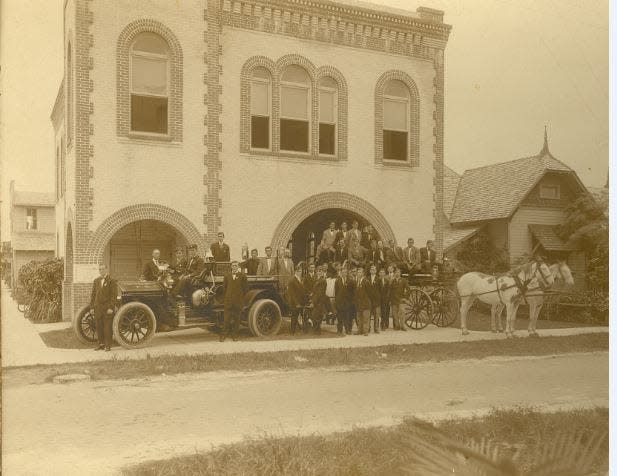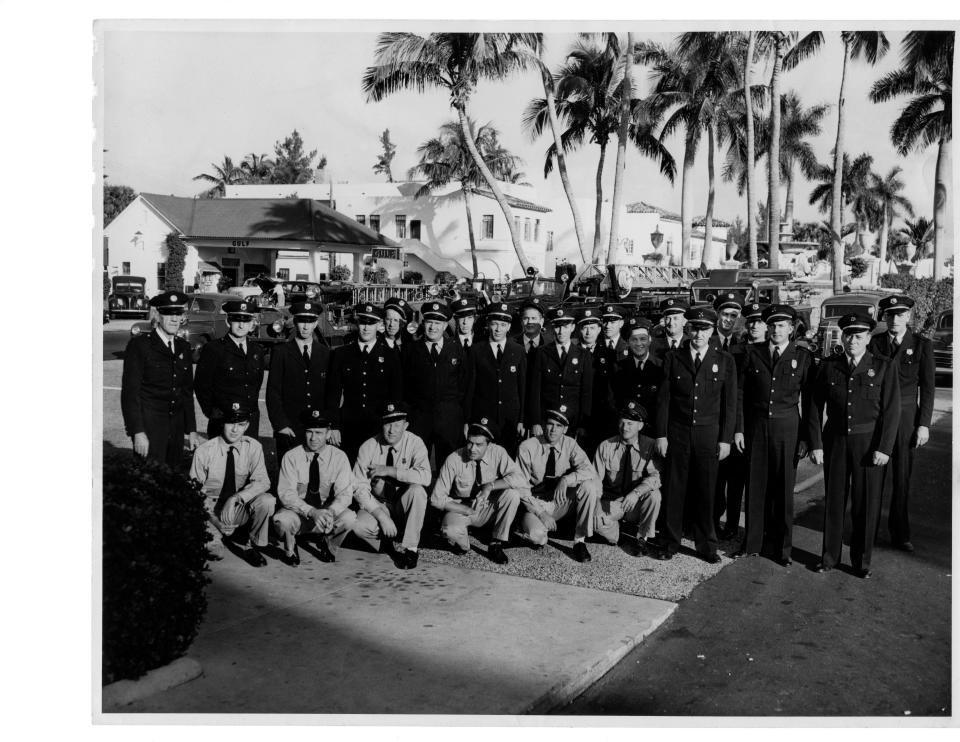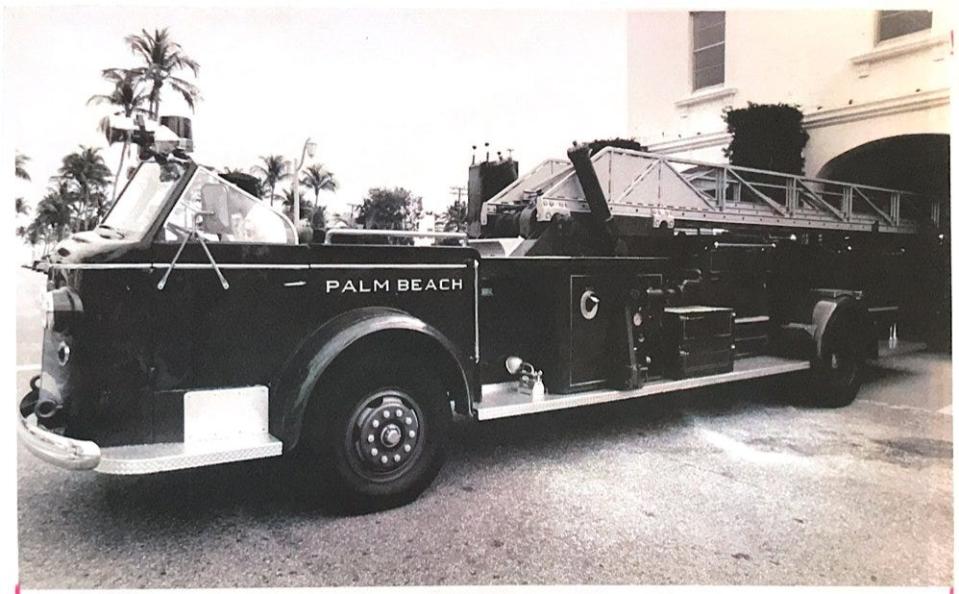A century of service: Fire-Rescue has grown into a sophisticated operation that answers thousands of calls a year
- Oops!Something went wrong.Please try again later.
The Palm Beach Fire-Rescue started in 1921 with a chief, two firemen and one red fire truck.
The department traces its beginnings to the Flagler Alerts, an all-volunteer firefighting group founded by Henry Morrison Flagler in West Palm Beach in 1894. In the early years after the Palm Beach Fire Department was launched, the town continued to depend on Flagler Alerts. The group was the basis of the West Palm Beach Fire Department, which was formed in 1911.
“The Town of Palm Beach is a community that is rich in history. At Palm Beach Fire-Rescue, we are so delighted to be an important part of that history,” Palm Beach Fire-Rescue Chief Darrel Donatto said.
“This December, our firefighters and our community will have the honor of celebrating the centennial anniversary of Palm Beach Fire-Rescue. We have been looking back at the fire department’s history from the beginning in 1921 to where it is today, and it has been an amazing journey of discovery,” said Donatto, who also serves as director of emergency management.
“One of our members, Driver Engineer Stuart Grimes, serves as our department historian. He has uncovered many interesting facts and pictures from the past,” Donatto said.

Community celebration: Fire-Rescue Department celebrates 100th anniversary on Public Safety Day
Growth: New Fire-Rescue equipment coming with help from Police and Fire Foundation donation
Until the late 1940s and early '50s, the department depended on volunteers. Since then, the department has grown to 70 certified firefighters, four full-time civilian employees and one part-timer, six full-time lifeguards and seven part-time lifeguards.
Fire-Rescue’s overall response time to all high priority calls for fiscal year 2021 was 5 minutes and 7 seconds, Donatto said. For high priority EMS calls, the average response time was 4 minutes and 42 seconds.
The department’s vehicle colors have evolved from red to yellow, then to lime green, then white and starting in 2008, back to the traditional red.
Today, each of the three Fire-Rescue stations contains at least one rescue unit and one fire suppression unit, and the Central and South stations contain an aerial ladder truck.
Over the years the department has responded to thousands of medical, fire and hazardous materials emergencies, averaging 2,600 calls each year, Donatto said. In the fiscal year 2021, Palm Beach Fire-Rescue responded to 2,659 calls. Emergency Medical Services accounted for 1,570 of the calls and fire calls totaled 1,089 with 22 being actual fires. Often, fire calls are because a fire alarm system detected smoke.
In 1972, the department began providing paramedical services. Helen Fraser donated the first mobile intensive care unit in memory of her husband, Andrew, a New York lawyer, who died of a heart attack en route to the hospital in 1969.
The fire department provided first aid for decades before that. It also provides fire safety inspections, emergency medical services education and community outreach programs.
In 1982, the department’s name was changed from Palm Beach Fire Department to Palm Beach Fire-Rescue.
Grimes, a 17-year veteran of the department, is a history buff who began researching the department’s history in 2008. He updated the information on the town’s website a few years ago.
Grimes led a group that produced the department’s first-ever anniversary book, “Town of Palm Beach Fire Department Centennial: 100 Years of Service.” Funded by the Palm Beach Police & Fire Foundation, the 100-plus book is filled with photos and will be distributed this year to fire department employees, the foundation’s board and town dignitaries.
Others who played a major role in producing the book were Lt. Rob Miraglia, Battalion Chief Ed Sabol and Police & Fire Foundation Executive Director Rebecca Torres. The foundation, funded by donations, covered the estimated $30,000 to $36,000 cost.

Origin traces to Flagler Alerts
Like much of Palm Beach’s history, the town’s fire protection roots have a connection to Flagler.
The Flagler Alerts, an all-volunteer group based in West Palm Beach, was founded on Nov. 17, 1894. Flagler organized it and donated the first pieces of equipment. It started with only a manually operated hose reel.
The only way to reach Palm Beach then was by boat, and beginning in 1896, by a wooden railroad bridge that crossed Lake Worth so trains could deliver passengers directly to the Flagler System hotels. Palm Beach was totally dependent on outside assistance to fight fires.
Flagler’s Palm Beach Inn directly on the ocean was renamed The Breakers and was destroyed in a fire in 1903. Its larger, more luxurious replacement burned down in 1925 and was replaced by the current landmark.
Palm Beach was incorporated in 1911, but it continued to depend on the Flagler Alerts, which became the City of West Palm Beach Fire Department in 1911. Under an agreement that endured until 1921, West Palm Beach charged Palm Beach $250 for each response to bona fide fire calls.
A 1919 Palm Beach Post article reported that the West Palm Beach Fire Department would no longer respond to fires in Palm Beach because the town owed it for the last three fires. That’s when the town decided it needed its own fire department for fire insurance purposes and for safety as response times were delayed.
“In December 1921, the town had raised enough money to purchase a fire engine. They hired a temporary fire chief, Joseph Borman, who was the police chief. Elmer Schultz Jr., a Flagler Alert, was hired to be the driver of the new fire engine,” Grimes said. “Two months later, he replaced Borman as fire chief.”
A history compiled by Retired Palm Beach Fire Capt. Robert Shinedling includes the details of the department’s beginnings.
Schultz was born in 1890 near Titusville and his family moved to Palm Beach County when he was a child. Before joining the fledgling Palm Beach fire service, he was a member of the West Palm Beach Fire Department.
As chief, he was paid $175 a month. By the time he assumed office, a 1921 American La France fire engine, a triple combination, pumping chemical and hose car Model #75 with pneumatic tires had been delivered. The $1,250 cost of the truck, which could pump up to 750 gallons a minute, was paid off in five years.
The new fire engine and crew of two plus the chief were housed in the town’s first fire station on Main Street, now named Royal Poinciana Way. The firemen were salaried at $100 a month.
In 1924, a second fire station, known as Central Station or Headquarters, was built on First Street, one block south of Worth Avenue and a second fire engine was purchased.
In 1925, a new town hall was built at Australian Avenue and County Road. It included space for the police and fire departments, but today the department is in a station built in 2004. The fire station on First Street was closed.
The biggest single job under Schultz was in 1925 when he supervised the battle against the old Breakers hotel fire.
In 1926, when as many as three fires occurred in a single day, concern about inadequate protection grew. Schultz called for a supplemental brigade of volunteer firefighters. Volunteers received $1 for each fire and were required to attend one paid fire drill per month. Volunteer participation ended in the late 1940s to early 1950s.
In November 1927, the Main Street (north end) fire station was closed when the fire station at the corner of Wells Road and County Road (Station 2) was opened. A third new American La France pumper was purchased. The station in town hall was remodeled in 1990.
Station No. 3, at 2185 S. Ocean Blvd. in Phipps Park, was originally the residence of the park attendant. It was remodeled to house a fire engine and squad truck, and opened for service in April 1964, according to the station journal of that year, Shinedling wrote. In 1995, a new South fire station was constructed to replace the old station.
The three-story North fire station, a landmarked building at 300 N. County Road built in 1927 is the third-oldest working fire station in Florida. The building, which houses department’s administration, is scheduled to undergo an estimated $5.5 million renovation. The town approved the measure in its $89.1 million operating budget in September. The leak-prone building has water damage and mold infestation, a recent inspection revealed.

Rebuilding: Fire station to undergo a renovation
A haunted fire house?
In his extensive research, Grimes has uncovered some information that is not widely known, such as the ghosts some say inhabit the North Fire Station.
“The North Fire Station is said to be haunted,” Grimes said. “A retired police officer named John “Jack” Smiley lived there. He retired in 1947, and died at the station in 1959. People have heard sink faucets turn on or toilets flush. They have heard footsteps. Some guys have been held down. They are drawn to certain people. Some have never had an incident.”
Grimes searched U.S. Census records from the 1930s through the 1950s to determine who lived at the fire station. He found there were three or four firefighters residing there at a time, but that Smiley, whose beat was Worth Avenue, was the only police officer who lived at the station.
“Back in the day, when you were fire chief, you lived at the station. That was your residence,” Grimes said. “That was how they got people to join the fire side. Firemen could also live at the station. It wasn’t just the chief.”
The town’s first chief, Schultz, lived on the top floor of the north station as did the next five chiefs who followed through 1978.
Schultz was headed to Lake Okeechobee for a fishing trip when he was killed in a car accident on June 15, 1941, on the newly opened State Road 26. The road, now known as U.S. 27, had opened to traffic on April 11, 1941. The chief was 51. The head-on collision 28 miles south of South Bay also claimed the life of his friend, George Vlahos of West Palm Beach.
The Town Council held a special session a few days after Schultz’s tragic death and named assistant fire chief Ralph Hardin as successor. Hardin, a 17-year veteran of the department, had been assistant chief since 1932. He served until his retirement in 1957.
During Hardin’s tenure, although the town didn’t officially employ paramedics, articles such as one from The Palm Beach Post on Dec. 18, 1955, make it clear that in addition to fire calls, the department staff performed first aid.
The article described firemen dedicated to working all night with a doctor to supply oxygen to a woman who had overdosed on a sedative and life-saving rescues of children found in swimming pools. The largest number of calls were in the “cuts and abrasions” category for the 12 months ended Oct. 31, 1955, followed by car accidents and heart attacks.
The town’s third chief was Clarence Peed, who was hired as a fireman in 1926 and became chief in 1957. Peed retired in 1969 after serving for more than 42 years. He died of cancer in 1988 at age 81. He also lived at the apartment at the North Station with his wife and two children.
Peed was described in his obituary as “A crusty Georgian who could swear like a sailor and didn’t take any lip from the rich,” but as a person who had a “heart of gold.”
Peed opened the South Fire Station in April 1964 to serve the burgeoning population in the South End.
Guilford Montgomery was the town’s fourth fire chief, serving from 1969 to 1973. He started with the department in 1941 and worked his way up. He was followed by Arthur Kitts, another department veteran, who served from 1973 to 1977, and David Crockett, who was chief from 1978 to 1980.
New chief, progressive ideas
A new era began in November 1981 when Chief Vincent “Ken” Elmore arrived from Washington, where he had worked as a firefighter for 23 years. He was the first chief to be selected from outside the department. Elmore was a progressive chief who combined the fire and emergency medical services, brought national recognition to the department, and introduced state-of-the-art equipment and facilities.
Elmore also was the first chief who chose not to live on the top floor of the North Fire Station.
In a 1981 Palm Beach Daily News interview, he said, “I don’t know where I am going to live, but I can tell you where I’m not going to live.” He said he didn’t want to bring his wife Shirley and their two children to work with him every day. The chief’s quarters were gobbled up by the department’s administrative staff for office space during a station renovation in 1985-86.
In a December 2000 Palm Beach Daily News article about Elmore’s retirement, Shinedling said that under Elmore’s leadership, the department went from being a “typical good old boy network” to one with an infrastructure that became nationally known.
Elmore said at the time that 70% of the department’s calls were for emergency medical services. During his tenure, town residents donated 11 vehicles to the department. Elmore died at 70 in 2007.
The town’s eighth chief, Kent Koelz, was appointed in March 2001. He had joined the department as a firefighter in September 1972. He retired in April 2004.
In a 2004 Palm Beach Daily News interview, Koelz said he was inspired to join the department while working for South County Road society photographers Bert and Richard Morgan. Hearing the trucks go by inspired him to become a firefighter.
Under Koelz, the department unionized, and, thus, began a difficult time as the town and the union spent several years trying to reach a contract agreement. Contract negotiations were lengthy and often bitter.
Koelz left in March 2004, three weeks before his planned retirement in April, and town officials brought in Ed Moran from Hollywood, where he had been fire chief. He arrived just in time for the ribbon cutting and dedication of the new Central Fire-Rescue station in December 2004.
In July 2005, the Town Council approved a labor contract with the department. Moran resigned in March 2007, saying he was “no longer able to effectively lead” his department because of “issues he and then Town Manager Peter Elwell were unable to resolve,” according to a March 15, 2007, Palm Beach Daily News article.
William Amador, who had risen through the ranks of Fire-Rescue, was appointed chief in August 2007. Amador was fired in 2011 as part of the fallout of an impasse in union negotiations.
In May 2011, Kirk Blouin, who has been town manager since 2018, became the director of public safety, overseeing both the police and fire rescue departments.
Blouin started working for the town as a police officer on the road patrol in 1989. He rose to the rank of major before being named chief of police in 2009.
In 2012, the Town Council made deep cuts to pay and pension benefits for public safety workers, saying it was necessary to put the retirement program on a sound footing, the Palm Beach Daily News reported. Morale plunged, and police officers and firefighters left their jobs.
A later council partially restored the benefits, and in 2019, the board approved pay increases for police and firefighters after a study showed their pay was not competitive in the local market. Pay grades were adjusted to be in the top 25% in police and fire departments in Palm Beach County.
Beginning in 2017, the council also began investing more than $5 million in additional funds each year into the retirement plan with a goal of shrinking an unfunded liability that threatened the program's long-term stability. The turnover rate has stabilized at 11% in fiscal year 2021.
Chief Donatto takes the reins
Donatto, who served as deputy fire chief under Blouin beginning in 2011, was promoted to fire chief in April 2018. In October 2018, he also was assigned the duties of director of emergency management.
Donatto spent the first 23 years of his career working in Riviera Beach before becoming a battalion chief with the town in 2004.
In a Palm Beach Daily News interview in 2020, he said Palm Beach doesn’t experience severe violent crimes and doesn’t have the same frequency of calls.
“What you do have in Palm Beach is the opportunity to take really good care of people,” Donatto said.
Of course, COVID-19 has had tremendous impacts on the department, both positive and negative, Donatto said.
Many of the department’s members contracted COVID and suffered through the illness and its effects, with several being hospitalized. One retired member died of COVID. In October, the Palm Beach Daily News reported a town estimate that fewer than half of its public safety employees were vaccinated against the virus.
“Because of COVID, we had to adapt many of our policies and practices to keep our crews safe and the community safe. From that we have learned a lot and will be better for the future. Should there ever be another pandemic or public health emergency, we will be able to respond to it better than ever before,” Donatto said.
“We developed an even better relationship than ever before with our county Health Department, and again, that will benefit the community into the future,” Donatto said.
Fire Rescue launched a vaccination program for the community on short notice and helped keep people within the town safe through early access to the COVID-19 vaccinations, he said.
“This has strengthened our ties to the community and really helped show the value of Fire-Rescue,” Donatto said.
This article originally appeared on Palm Beach Daily News: Palm Beach Fire Department celebrates centennial anniversary

